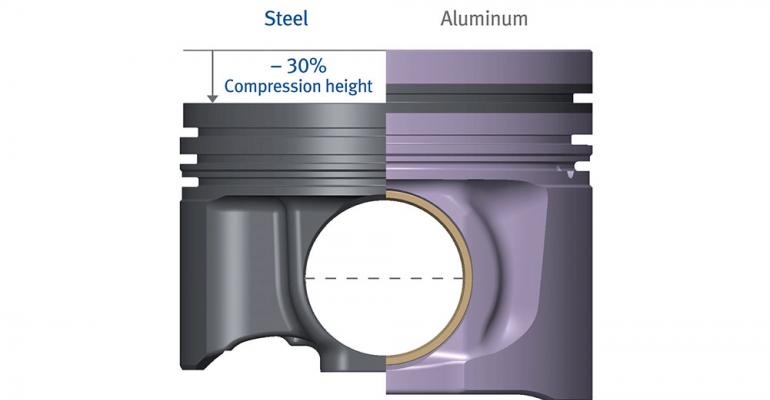DETROIT – It’s been decades since the auto industry migrated from machined cast iron to aluminum alloy as a base material for pistons in light-vehicle internal-combustion engines.
Today, aluminum is facing a challenge as piston makers seriously consider steel as a core material because of its rigidity, resistance to thermal expansion and lower cost.
Steel pistons have been common in medium- and heavy-duty trucks, but automakers now are highly interested in steel pistons as a way to reduce friction and fuel consumption while producing more power, says Horst Binnig, CEO of German piston supplier KSPG Automotive.
“Now we see steel going into mass-volume production for pistons,” Binnig tells WardsAuto during the recent North American International Auto Show here.
The move toward turbocharged gasoline direct-injection engines has raised operating temperatures to the point that aluminum pistons are under tremendous stress. They expand, causing excess friction within the combustion chamber.
Steel has different thermal properties and is able to resist expansion even as engine specific loads rise from about 50 kW to as high as 80 kW today, says Alexander Sagel, president of KSPG’s Kolbenschmidt piston unit, currently the world’s No.2 piston maker.
“With steel, you have much better control over friction, and you can significantly reduce friction between the skirt and the liner,” Sagel says, adding the thermal expansion coefficient of aluminum is 26; for steel, it’s seven. “That means aluminum is three times more likely to expand.”
Steel is heavier than aluminum. But, when combined as a system with optimized hardware such as rings, liners and pins, steel pistons actually can result in an overall weight savings, Sagel says.
“This is driving a 3% to 5% fuel-economy improvement,” he says. “These numbers are coming from customers who are buying this piston.”
KSPG can’t reveal the customers yet, but the supplier this year begins production of a steel piston for a high-performance gasoline V-6.
Light-vehicle diesel pistons also have been made of aluminum, but Sagel says KSPG’s second contract for steel pistons is for a 1.6L 4-cyl. diesel.
Another automaker testing a 2.0L diesel engine with KSPG’s steel pistons and optimized friction reduction achieved a fuel-economy improvement of 4.5%, Sagel says.
There are packaging considerations as well. A steel piston is more rigid than one made of aluminum, so it can be smaller. The piston crown can sit 30% lower than with an aluminum piston, allowing an automaker to reduce an engine’s deck height during the design phase, Binnig says.
Lowering an engine’s deck height by millimeters may seem inconsequential, unless a vehicle is struggling to meet pedestrian-protection requirements in Europe.
“Ten years ago, no one was thinking seriously about applying steel pistons into passenger cars,” Sagel says.
KSPG can manufacture a steel piston as a 1-piece forging, and the supplier has patents for both the design and process, which Sagel describes as “a kind of warm bending process.”
Switching to steel pistons makes sense for an automaker developing a performance engine that will routinely run at high rpm, he says.
With the potential fuel-economy gain, steel pistons could be attractive to automakers having a long way to go in meeting Europe’s pending emissions mandate of 95 grams of carbon-dioxide per kilometer driven.
In terms of pricing, Sagel says a steel piston yielding a 1% fuel-economy gain will cost an OEM less than $27 per unit. “I think that’s a very good deal,” he says. “To take the tribology, the friction, out of the engine, is always a quick way (to boost mileage).”
Binnig has worked for KSPG since 1999 and has expertise in engine blocks, cylinder heads and structural components, as well as pistons and bearings. He became CEO Jan. 1, replacing the retiring Gerd Kleinert.
The piston business is strong, Binnig says. KSPG had a plant within Shanghai producing about 6 million pistons annually. The plant was moved just outside of Shanghai and expanded, and production already has ramped up to 8 million pistons annually. Capacity soon will be maxed out.
“We can say within three years, we will go from about 8 million pistons to slightly above 12 million,” he says. “And the request from the market is 20 million pistons.” Most pistons manufactured at the plant are for international automakers for the domestic market.
The pace of growth in China is astounding, Binnig says.
Two years ago, KSPG opened a plant there for casting engine blocks and cylinder heads. In 18 months, the supplier ramped up high-pressure die-casting of engine blocks to 1 million units. Cylinder-head production already has topped 4.5 million units.
“I will be in China in two months, and we will have our opening ceremony for the next plant on the opposite side of the street,” he says.
Besides China, Binnig says KSPG is investing in new facilities in Mexico to meet market demands, while safeguarding against too much capacity if the industry takes a downturn.
“We don’t want to fall into the same trap like we did in 2008 and 2009. We have close contact with our customers,” he says. “If something happens like that, we’ve got to react immediately, with both feet on the brake. What else can you do?”





